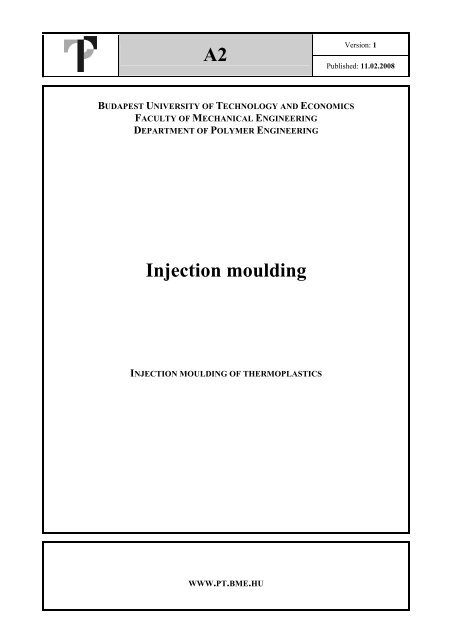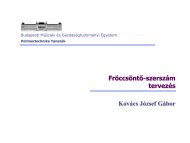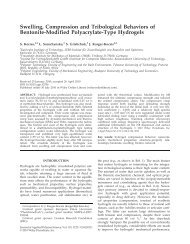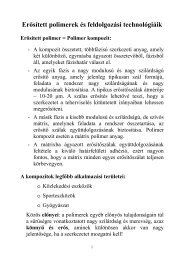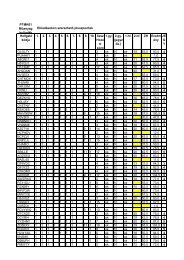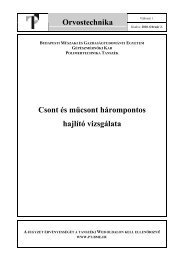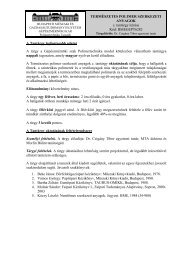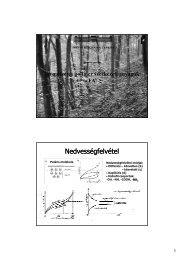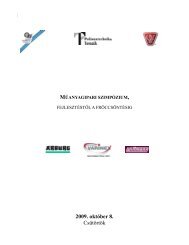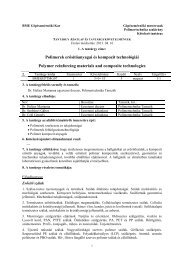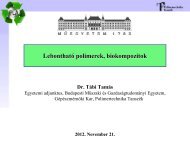A2 Injection moulding - BME - Polimertechnika Tanszék
A2 Injection moulding - BME - Polimertechnika Tanszék
A2 Injection moulding - BME - Polimertechnika Tanszék
Create successful ePaper yourself
Turn your PDF publications into a flip-book with our unique Google optimized e-Paper software.
Version: 1<strong>A2</strong>Published: 11.02.2008BUDAPEST UNIVERSITY OF TECHNOLOGY AND ECONOMICSFACULTY OF MECHANICAL ENGINEERINGDEPARTMENT OF POLYMER ENGINEERING<strong>Injection</strong> <strong>moulding</strong>INJECTION MOULDING OF THERMOPLASTICSWWW.PT.<strong>BME</strong>.HU
a2 – INJECTION MOULDINGVersion: 1Published: 11.02.2008LOCATION OF THE PRACTICE2TABLE OF CONTENTS1. AIM OF THE PRACTICE ...................................................................................................................... 32. THEORETICAL BACKGROUND......................................................................................................... 32.1. THE HISTORY OF INJECTION MOULDING.............................................................................................. 32.2. THE INJECTION MOULDING MACHINE ................................................................................................. 42.3. MAIN STEPS OF INJECTION MOULDING................................................................................................ 52.4. THE SEQUENCES OF THE INJECTION AND THEIR UNITS ........................................................................ 62.5. THE INJECTION PROCESS AS A FUNCTION OF THE PARAMETERS .......................................................... 93. THE MACHINES USED AT THE PRACTICE.................................................................................. 114. THE MOST IMPORTANT TERMS RELATED TO THE INJECTION MOULDING INHUNGARIAN, IN ENGLISH AND IN GERMAN...................................................................................................... 125. LITERATURE (IN HUNGARIAN)...................................................................................................... 12REPORT ........................................................................................................................................................... 13<strong>Injection</strong> <strong>moulding</strong> of thermoplastics 14/2
a2 – INJECTION MOULDINGVersion: 1Published: 11.02.20081. Aim of the practiceThe aim of the practice is to come to know, and to analyse the technology of injection<strong>moulding</strong>. The injection <strong>moulding</strong> machine and its parts are to be studied. In addition, the injection<strong>moulding</strong> technology, and effect of the parameters (injection pressure, cooling time, shot volume)on the part are to be studied too.2. Theoretical backgroundThe injection <strong>moulding</strong> is the most versatile technology of producing polymer (mainlythermoplastic polymer) products. Its principle is that the raw material (polymer pellets) is heatedabove its melting temperature (creating a viscous polymer melt) and is injection moulded with highspeed and pressure into a closed mould. In this mould the high pressure polymer melt cools, andforms an optionally complex, dimensionally accurate (3D) part, practically without waste. With themould used, only one type of product can be injection moulded, these moulds are not universal. Amould for injection <strong>moulding</strong> is not cheap, but because a great number of products (at least100.000) are made by the same mould, the price for one product is low.2.1. The history of injection <strong>moulding</strong>The injection <strong>moulding</strong> process has its roots in the injection <strong>moulding</strong> of metals as well as inthe extrusion of polymers. In the early days the development of the process almost entirely focusedon perfecting and increasing the melting capacity. The melting cavity used in the metal injection<strong>moulding</strong> was equipped with a torpedo in order to increase the heat exchange surface and decreasethe melt thickness. This increased melt homogeneity. These were the piston type injection <strong>moulding</strong>machines.A theoretically new method is the pre-plasticating of the polymer to increase the meltingcapacity. Formerly this method was applied in a piston driven pre-plasticating barrel equipped witha torpedo. In the later designs the piston-driven barrel was replaced with a screw driven one.The main problem with both the piston driven and screw driven machines was to make theoutlet of the melting space lockable, and to maintain a controllable back-pressure. Before findingsolutions to these technical difficulties, the reciprocating screw injection machine was invented.<strong>Injection</strong> <strong>moulding</strong> of thermoplastics 14/3
a2 – INJECTION MOULDINGVersion: 1Published: 11.02.2008This was a big advance in the melt homogeneity and melting capacity of the machine. We willanalyze the injection <strong>moulding</strong> process on a reciprocating screw injection <strong>moulding</strong> machine.2.2. The injection <strong>moulding</strong> machine<strong>Injection</strong> <strong>moulding</strong> is the process of choice for a tremendous variety of parts in size, shapeand material. To accomplish optimally this task, a great number of injection <strong>moulding</strong> machinetypes were developed. In general, the main parts of an injection <strong>moulding</strong> machine are (Fig 1.):Fig.1. The main parts of the injection <strong>moulding</strong> machineThe function of the machine bearer (Fig. 1 – 1) is to join the other main systems of themachine.The function of the clamping system (Fig. 1 – 2) is – basically – the moving of the movablemould half. During injection <strong>moulding</strong> the mould must be kept closed against the high pressurefrom the molten polymer (the clamping force is one of the main parameters of an injection<strong>moulding</strong> machine). When the part is cooled down to a certain temperature in the mould, the mould<strong>Injection</strong> <strong>moulding</strong> of thermoplastics 14/4
a2 – INJECTION MOULDINGVersion: 1Published: 11.02.2008must be opened in order to remove the product. The clamping system can be either mechanical(toggle mechanism) or hydraulic (Fig. 2.).Fig.2. The scheme of the toggle mechanism (mechanical clamping system)The injection system (Fig 1. – 3) is the main system in the injection <strong>moulding</strong> machine. Itsfunction is the melting (homogenous melt) of the raw material, and to inject it into the mould.The function of the control unit (Fig 1. – 4) is to control the main parameters of theinjection <strong>moulding</strong> machine, and to assure the contact between man and machine.A mould is also required for injection <strong>moulding</strong> (Fig 1. – +), but it is not a main system ofthe injection <strong>moulding</strong> machine, because it can be used in more machines, and a machine canoperate with different moulds.2.3. Main steps of injection <strong>moulding</strong>Most thermoplastic materials are processed by injection <strong>moulding</strong> into products. In this casethe process consists of the following steps:– Filling the hopper with raw material,– Conveying, melting and homogenisation of the material,– Injecting of the melt into closed mould with high pressure,– The cooling of the melt in the cold mould (to a certain temperature),– Removing the complete product from the mouldThe injection cycle consist of the above steps; their order and interaction can be understoodby the theoretical process diagram (Fig. 3.).<strong>Injection</strong> <strong>moulding</strong> of thermoplastics 14/5
a2 – INJECTION MOULDINGVersion: 1Published: 11.02.2008Fig. 3. Process diagram of injection <strong>moulding</strong>After closing the mould and the injection unit, the melt (prepared one cycle before) isinjected into the mould by the axial movement of the screw (injection). After injection, the meltcools down and solidifies in the mould, while the injection unit prepares the melt for the next cycle.The screw rotating in the barrel conveys the material forward, which is melted by the heating andby the shearing action (plastification). When sufficient material is melted, the rotation of the screwstops, and the injection system retracts form the mould in order to avoid the heat transfer betweenthe (cold) mould and the (heated) nozzle (part of the injection system). After the part is cooled inthe mould, the mould opens and the product can be removed. (removing). The injection <strong>moulding</strong>cycle recommences (Fig. 3.).2.4. The sequences of the injection and their unitsThe injection system (Fig. 4.) is the main system considering the process. Its functions are asfollows:– Melting the raw material– Melt conveying and homogenization– Melt accumulation<strong>Injection</strong> <strong>moulding</strong> of thermoplastics 14/6
a2 – INJECTION MOULDINGVersion: 1Published: 11.02.2008– Injecting of the melt into the mould– Provides the necessary holding pressureFig. 4. <strong>Injection</strong> systemThe essence of the plastification process is: The solid pellets drop (due to gravity) from thefeed hopper into the feed zone of the screw. As the screw rotates the solid pellets are conveyed inthe direction of the screw tip. The material is heated due to the (external) barrel heating and due tothe (internal) viscous friction, and finally melts. The melt homogeneity (both physically andthermally) can be controlled with the barrel heating, the geometry of the screw and the screw speed.In order to achieve optimum melting homogeneity in short time, the screw has three separatesections (zones) (Fig. 5.). In the feed zone (Ød=const.), solid resin granules are compressed andconveyed in the direction of the screw tip and nozzle.Fig. 5. Three-zone screwThe middle part of the screw is the compression (ØdØD) or transition zone. Here thematerial melts completely and compressed sufficiently to force trapped air back to the hopper. Inthe final metering zone (ØD=const.) the melt is homogenized and stabilized further.The melt reaching the nozzle does not enter into the mould immediately. The melt shouldenter into the mould at high speed in order to fill completely the cold mould. It is not feasible tobuild such plasticating unit that can melt the solid material with the required high speed and at thesame time provide good melt homogeneity. So the melt should be stored before injection. In thereciprocating screw injection <strong>moulding</strong> machines the screw can move axially. As the melt<strong>Injection</strong> <strong>moulding</strong> of thermoplastics 14/7
a2 – INJECTION MOULDINGVersion: 1Published: 11.02.2008accumulates in front of the screw tip, pressure is building up which forces the screw backwards. Asthe screw reaches a certain distance (it already had produced sufficient amount of melt), it stopsrotating. On the end of the barrel next to the mould an adapter called nozzle is fastened to the barrel.This nozzle provides mechanical and thermal connection between the hot barrel and the muchcooler mould. The melt flows through this nozzle.The injection, the second most important task of the injection system is to inject the meltthat is accumulated in front of the screw tip, into the closed mould. This should be carried out ratherfast in order to avoid premature freezing of the melt. The melt has high viscosity, so the injectionneeds high pressure; this is why the screw should move forward fast and with high pressure. Thewhole injection process should be controlled to avoid damage to the mould or to the melt.During this phase the melt must not flow backwards. The non-return valve prevents the meltto flow back while the pressure is higher in front of the screw tip than behind it. (Fig. 6.)Fig. 6. The non-return valveAfter the injection the melt cools down in the tempered mould, solidifies (at first near themould walls) and shrinks. A part of the volume decrease (shrink) can be compensated for byapplying a holding (packing) pressure. During the holding pressure phase the screw moves forward(slowly) and melt is forced into the mould. This phase lasts until the melt solidifies (most probablyat the gate – where the channel is the narrowest). In order to transmit the pressure from the screw tothe mould a melt pool should exist during the whole injection cycle in front of the screw tip. Afterthe holding pressure phase the screw starts rotating and a new cycle starts.The solidified melt – our end product – should be removed from the mould cavity. The maintask of the clamping side is to open and close the mould, which is achieved by toggle mechanismsor by hydraulic clamping systems. Typically, a short stroke hydraulic cylinder operates the togglemechanism. The clamping side should withstand the high injection pressure (during the injectioncycle the mould should be closed).The parts are cooled down until they can be ejected without distortion. At this time themould opens and a separate knocking mechanism removes the parts. After a while the mould closes<strong>Injection</strong> <strong>moulding</strong> of thermoplastics 14/8
a2 – INJECTION MOULDINGVersion: 1Published: 11.02.2008and a new cycle can be started. In the up-to-date injection machines all phases of an injection<strong>moulding</strong> cycle can be controlled very precisely.2.5. The injection process as a function of the parametersThe process in the mould can be understood as the function of the p, v, T parameters (Fig.⎛ 17.). The specific volume ⎟ ⎞⎜v = of the polymers is largely affected by the outer (hydrostatic)⎝ ρ ⎠pressure (p) and by temperature (T). At the same pressure, the specific volume change of thepolymers as the function of the temperature is higher even in solid state than all of the otherstructural materials: which also results in higher heat expansion coefficient.Spencer and Gilmore (1950) were the first to publish, that the parameters of the polymerscan be described as an equation, analogous to the law of the gases, known from thermodynamics:RT( p + π)(v− ω)= , (1)Mwhere p is the hydrostatic pressure, v is the specific volume, R is the universal gas constant, T is theabsolute temperature, M is weight of the monomer unit of the polymer chain, π , and ω arecorrection constants.The injection process as the function of the p, v, T parameters are as follows (Fig. 7.):Fig. 7. p-v-T diagram of the injection cycle<strong>Injection</strong> <strong>moulding</strong> of thermoplastics 14/9
a2 – INJECTION MOULDINGVersion: 1Published: 11.02.2008– 1-2: The polymer melt fills the mould cavity (injection),– 2-3: Switchover to holding pressure,– 3-4: Holding pressure, stands till point 4, where the thinnest part of the product isfrozen,– 4-5: The melt – at constant specific volume – cools, while pressure decreases,– 5-6: Isobar cooling,– 6: Removing of the product,– 6-7: The product cools and shrinks further in the open air<strong>Injection</strong> <strong>moulding</strong> of thermoplastics 14/10
a2 – INJECTION MOULDINGVersion: 1Published: 11.02.20083. The machines used at the practiceMaximum volume: 100 g (PS)Maximum clamping force: 25 tClamping: Toggle mechanism(Hydromechanic)KUASY 100/25 INJECTION MOULDING MACHINE (FIG. 8.)Distance of columns: 280*280 mmScrew diameter: 35 mmFig. 8. KuASY type injection <strong>moulding</strong> machineARBURG ALLROUNDER 320C INJECTION MOULDING MACHINE (FIG. 9. )Maximum volume: 132 g (PS)Maximum clamping force: 60 tClamping: HydraulicDistance of columns: 320*320 mmScrew diameter: 35 mmMaximum injection pressure: 1820 barFig. 9. ARBURG Allrounder 320C type injection <strong>moulding</strong>machine<strong>Injection</strong> <strong>moulding</strong> of thermoplastics 14/11
a2 – INJECTION MOULDINGVersion: 1Published: 11.02.20084. The most important terms related to the injection <strong>moulding</strong> inHungarian, in English and in GermanHungarian English Germanfröccsöntés injection <strong>moulding</strong> Spritzgiessenfröccsegység barrel Plastifizier-einheitbeömlőcsatorna Sprue Anguss (Zapfen, Kegel, Stange)elosztócsatorna runner Verteilungskanal (Angussverteiler)csigadugattyú reciprocating screw Schneckefröccsnyomás injection pressure Spritzdruckutónyomás holding/packing pressure Nachdruckszerszám Mould Werkzeughűtés cooling Kühlungzsugorodás shrinkage Sohrumpfenvetemedés warpage Verziehenösszecsapási vonal Weld line Bindenahtzáróerő clamping force Schliesskraftszerszámzáró egység clamping unit Schliesseinheit5. Literature (in hungarian)1. Czvikovszky T., Nagy P., Gaál J.: A polimertechnika alapjai, Műegyetemi Kiadó,Budapest, 20002. Dunai A., Macskási L.: Műanyagok fröccsöntése, Lexica Kft., Budapest, 2003<strong>Injection</strong> <strong>moulding</strong> of thermoplastics 14/12
a2 – INJECTION MOULDINGVersion: 1Published: 11.02.2008REPORTName:Grade:Neptun code:Date:Checked by:Head of practice:1. The task– Set up the injection <strong>moulding</strong> parameters for the KuASY injection <strong>moulding</strong>machine to make a perfect product.– Inspection of the cycle, measuring of the parameters required to draw the cyclediagram (cycle time, mould closing and opening time, temperature profile, etc.).– Draw the cycle diagram, from the measured parameters.2. Basic, measured, and counted data:Temperature profileRaw material:At nozzle: [°C] Density: [g/cm 3 ]Middle: [°C] Mass: [g]At throat: [°C] <strong>Injection</strong> volume: [cm 3 ]<strong>Injection</strong> pressure: [MPa] Holding pressure: [MPa]<strong>Injection</strong> time: [s] Holding time: [s]Screw shift at injection time:Screw shift at holding[mm]time:[mm]Mould closing time:Mould opening time:[s][s]<strong>Injection</strong> unit closingtime:<strong>Injection</strong> unit openingtime:[s][s]Screw rotation time:Cooling time:Cycle time:[s][s][s]<strong>Injection</strong> <strong>moulding</strong> of thermoplastics 14/13
a2 – INJECTION MOULDINGVersion: 1Published: 11.02.20083. Cycle diagram of injection <strong>moulding</strong><strong>Injection</strong> <strong>moulding</strong> of thermoplastics 14/14


